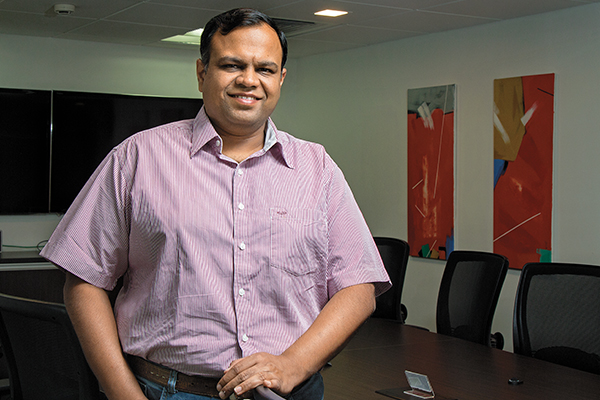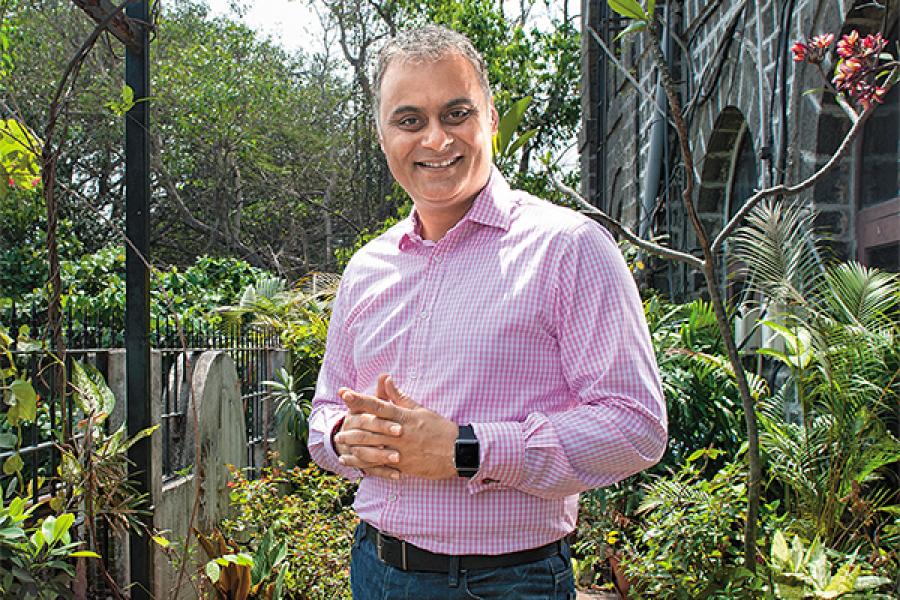
Hungama on track to become the default entertainment platform in India
Neeraj Roy is betting big on video, original content and deals with smartphone vendors to transform Hungama into a successful entertainment platform
Long before smartphones and ecommerce came of age in India, Neeraj Roy was betting his digital entertainment and marketing business Hungama Digital Entertainment, then called Virtual Marketing India, on Amazon.com’s elastic cloud and web services. He has been so successful in leveraging the cloud that today a simple keyword search for his group company Hungama Digital Media Entertainment brings up an ad of a case study highlighting its shift from in-house computer infrastructure to Amazon Web Services: The world’s largest internet-based computing and storage network that businesses can rent.
The cloud computing push in 2008-09, after nearly a decade of operations, was in part urgent business need—the company’s business clients wanted quick and flexible options for marketing campaigns, for instance. It was also informed foresight. The following year would see Saavn—then a joint venture between Hungama Mobile, a division of Roy’s Virtual Marketing India Pvt Ltd and New York’s 212 Media—break away into a separate company focusing on the consumer segment, a departure from serving largely business customers until then.
Even as Saavn’s birth as a business-to-consumer (B2C) music streaming company was under way, Virtual Marketing India was seeing its own transformation. It would soon metamorphose into its current avatar: The group Hungama Digital Media Entertainment. And Hungama Mobile would soon become hungama.com, a provider of high-quality streamed music and video from regional and international sources.
The rapid shift from a B2B (business to business) to a consumer- oriented company is the perfect testament of Roy’s technology savvy and his passion for entertainment distribution, a combination that has formed the underpinnings of Hungama’s success so far. The two traits are even more critical now as Hungama is evolving to stay ahead of the game in a future that will be dominated by on-demand digital content, especially video.
“I see entertainment becoming the next big catalyst for internet penetration,” says Roy, 48, who contends that significantly more Indians will be willing to pay for video streaming.
Simultaneously, Hungama is embarking on a series of partnerships—most recently with China’s Xiaomi Corp—that re-envisage the way Indians view entertainment, by putting the smart device at the heart of every transaction.
These partnerships are also early evidence of the potential of the Internet of Things (IoT). For instance, Hungama is aware of the potential of biometrics in bringing up a driver’s favourite playlist in a vehicle’s entertainment system. Along with its many partners, Hungama is helping build an ecosystem where the customer doesn’t just stream or download a song on to his/her phone. It’s about opening a banking app on a smartphone to choose a video, paid for through a mobile wallet, which will then be streamed seamlessly into a car’s entertainment system. In the unified ecosystem that Hungama envisages, gaming concepts such as rewards for various actions are already being built in, and users will get to trade their points and credits across online games, entertainment, and discounts in offline purchases.
“At the core, Hungama is going to be the default entertainment platform for India, whether you run the stereo system in a connected car, or on your desktop or a smartphone,” says Vishal Gupta, managing director in India of the global venture capital firm Bessemer Venture Partners, which has invested twice in the company. “The shift to video is the biggest pivot,” Gupta adds. “Going into 2016 and 2017… a big theme is going to be video,” concurs Roy.
There were 31.9 million unique online video viewers in India in March 2011 who watched 1.86 billion videos, according to consultancy firm Deloitte in a 2015 report titled, ‘Digital Media: Rise Of On-demand Content’. The number of online video viewers increased by 69 percent to 54 million in March 2013 and they watched 3.7 billion videos. By end-2014, online video viewers crossed the 200 million mark, adds the report.
Today, Mumbai-based Hungama reaches about 64 million consumers each month “through Hungama-branded services,” Roy says, adding that about 16 million people transact with the company in some form every month. Currently, most users consume music, but Roy says video is where the serious apps will be differentiated from the also-rans. “We’re very excited that this is the category that consumers are now ready for,” he says, playing a scene from the Salman Khan movie Prem Ratan Dhan Payo on the Hungama Play mobile app. “And this [the movie] is running on a 3G network,” he adds. That he was demonstrating it on an iPhone 6 Plus helped, but the point was well made: Hungama is offering content encoded in seven formats, from ones light enough to work on an EDGE network all the way to HD formats that play when high speed 4G is available.
The objective is to move the consumer to the most optimal format based on signal strength, says Siddhartha Roy, CEO of hungama.com, the flagship company of the Hungama Digital Media group, and Neeraj Roy’s cousin. (Celebrity site Bollywood Hungama, online games joint venture Vroovy and Artists Aloud, a platform for independent artists are among the group’s other ventures.)
“We are a homegrown digital content company that has served a quarter of a billion unique consumers over the last decade,” says Allahabad-born Neeraj Roy, emphasising his company’s made-in-India credentials.
Hungama is therefore building a range of services all centred around digital content and based on experience gleaned from selling to “Middle India” over the last decade. That includes some 350 partnerships with various types of content providers, cumulatively generating about $1.5 billion (around Rs 10,000 crore) in end-consumer-based revenue for telecom utilities and others over a decade, says Roy, who is now managing director and CEO of Hungama Digital Media Entertainment.
“We are hard-nosed about delivering value to the consumer and getting value back into the broader content ecosystem,” he says. “If one rupee is the price at which a consumer will buy something, I’ll deliver a service at that price point, if it’s Rs 99, I’ll deliver at that.”
Complexities in pricing apart, broadband access is the other important inhibitor to streaming services, says Jehil Thakkar, a partner at KPMG India, who heads the consultancy’s media and entertainment practice. “Remove those inhibitors, and the market will explode.”
Today, with about one in four people paying for some Hungama service—including over-the-top (OTT) content streaming via cellphone networks, tie-ups with satellite TV providers and broadband internet service providers—the company has an overall monthly ARPU (average revenue per user) of Rs 16-18, says Roy. Sometime in the current fiscal year, he expects Hungama to hit an annual revenue run-rate of $100 million (around Rs 660 crore).
As the company launches new offerings—such as the movie service launched in July last year—Roy expects the needle to move on earnings as well. Hungama’s movie streaming service is priced at Rs 249 a month and provides unlimited subscription to 6,000 titles. Another 1,500 titles are available for a one-time fee per title. So, while Prem Ratan Dhan Payo is available as part of the subscription, a Hollywood movie like Black Mass will be charged Rs 120. Hungama, which is already offering movies from Disney and Marvel, will soon add movies from Sony Pictures too, says Siddhartha Roy.
To its list of movie titles, Hungama will soon add exclusive content too. The company is using the money it has raised—about $40 million in mid-2014 and another $25 million in a round led by Chinese smartphone maker Xiaomi Corp on April 4 this year—to produce its original shows. Bessemer Venture Partners, which led the 2014 investment round, returned to invest more alongside Xiaomi, as did Intel Capital, another existing investor.
“The manner in which the amalgamation of content and devices has happened in China, I think there is a lot to learn from there,” says Neeraj Roy of the Xiaomi partnership.
Xiaomi smartphones—which have gained a strong following among India’s youth—could become more attractive with a host of Hungama-branded content bundled in by default in India. The two companies were hammering out the details, Roy said. And this is not the only such partnership for Hungama. The company has offered some of its content for free over a limited period to buyers of the OnePlus smartphone.
“At Xiaomi, we think of smartphones as a platform to deliver internet services, and this includes [audio and video] content. We are investing in Hungama not only to start integrating content into our smartphones, but also to grow together with them and deepen our understanding of the content sector in India,” explains Hugo Barra, Xiaomi’s vice president for international operations. “We have chosen Hungama because of what they are doing in terms of aggregating large amounts of content and delivering an amazing user experience.”
“At Hungama, we have already commissioned our first original [content] and it’s going to be available in episodes. It will be a Hindi-English mix,” explains Roy, adding that the first episode will roll out in the July-September quarter of this fiscal.
Over the next three to four years, the task is to move towards a monthly ARPU of Rs 90-100 at which time Roy expects Hungama to have customers north of 150 million and “a certain percentage of that community will be transacting with us as daily-, weekly- or monthly subscribers”.
But Hungama has competition, especially from Saavn on the music front. Its off-shoot has raised $100 million recently and is working on audio beyond mainstream music (which includes genres like comedy and sports radio). Likewise, Airtel Wynk, the music streaming and downloading app of the country’s largest telecom operator Bharti Airtel, has been downloaded 12 million times within a year of its launch, the company said in December 2015. Bharti has since added games and movies as well.
Apple music is available in India and Netflix too has made an entry though these two are targeting a fairly niche, and relatively wealthy, segment of the Indian market. Companies less-known in India, such as Rdio—which acquired the music streaming service Dhingana to boost its Indian library of music—and Guvera are also offering their music streaming services in the market.
KPMG’s Thakkar declines to comment on individual companies, but says the industry in India is so nascent that it’s too early to call out winners and losers. “I think we are at the first floor of a 30-storey building at this point,” he says, and adds that many things will change over the next two to three years, including broadband penetration and speeds. In that time frame, India will see its internet user base increase by another 350 million smartphone owners, and Roy anticipates that a majority of them will use their smartphones for some form of entertainment.
And Hungama is prepared. Be it with its use of AWS or its modern content delivery network from Akamai Technologies, it is already leveraging the networks of telecom providers and internet service providers, to become relevant to a range of regional users from Bhojpuri to Malayalam, says Roy.
Hungama Drive, the company’s partnership with luxury carmaker Jaguar Land Rover earlier this year, will soon find its way into another major auto brand, says Siddhartha Roy without elaborating further. “The technology was built by Robert Bosch and we are working directly with their R&D teams,” he adds. “Stuff like this takes time to get right. These are going to be placed in 5-10 million cars and they will have to work flawlessly.”
‘Gamification’ is another big draw at Hungama. Add a song to your playlist and you get points, download something and you get more points. The accumulated points can be redeemed against other digital goods across a gradually widening ecosystem of partners, which Neeraj Roy envisages will eventually include every business that can benefit from using Hungama as a means to reaching large numbers of potential and existing customers.
Last year, Hindustan Unilever Limited (HUL) teamed up with Hungama to promote its Kwality Walls Cornetto cone ice creams. Buy a Cornetto, scratch the wrapper for a code and use it to download 200 songs for free on Hungama’s Android app. The winners also had to enter valid details, including their email IDs and cellphone numbers—a treasure trove of data for marketers at HUL and Hungama.
The whole country and all its businesses are rife with potential, from Roy’s perspective: “How can a two-wheeler maker look at its 20-million customer base and use entertainment services from a partner like us to engage with that customer base?”
Today’s Hungama is an evolution of something that started around 16 years ago. Along the way, businesses were tried, discarded, built and successfully sold as well (as in the case of the digital marketing services unit that was bought by WPP, one of the world’s largest ad companies). Acquisitions were made too, as in the case of IndiaFM.com, now Bollywood Hungama, which is “still run by its founders even though we own 100 percent,” Roy takes pride in pointing out.
Looking ahead, “If 2015 was a year of this,” Roy says holding out his open palm, fingers splayed, “2016 will be a year of this,” he adds making a fist—pointing to the consolidation that’s coming.
And Roy is open to more acquisitions. “If there are real meaningful communities out there, I wouldn’t hesitate to look at ways of consolidation.” Over the next three years, “we would like to retain and consolidate our leadership [and] become an integrated business with music, movies and TV all under one roof,” he says. “Where we would like to innovate is, how people access us, and how they pay for those services.” Given Roy’s long years in delivering digital entertainment, one can expect Hungama to lead the charge as video-streaming strikes root in India.
 Image: Bmaximage
Image: BmaximageVishal Gupta
When Hungama Showed Bessemer the Money
The company’s strong revenues convinced investors that streaming services can be monetised in India
Bessemer Venture Partners led a $40 million investment in Hungama Digital in mid-2014, and returned to invest more this year. Hungama didn’t have a video platform in 2014 but there was a plan to move in that direction.
“When I first met him [Neeraj Roy], I was worried about how low the monetisation is [in India], but then he showed me the numbers and I was taken aback,” recalls Vishal Gupta, the India managing director of Bessemer.
The numbers Gupta had seen till then were for other streaming services that were projecting annual revenues of Rs 2-5 crore. “He [Neeraj Roy] showed me Rs 60 crore and it was stunning.” This was the revenue run-rate Hungama had projected to hit during the 2014-15 fiscal year.
“The biggest surprise was that this Rs 60 crore was net to Hungama,” says Gupta. Hungama users were cumulatively shelling out nearly Rs 120 crore annually on the service, about 10-15 percent of that was going as taxes and about 40 percent was what Hungama’s telecom partners were taking away. “I hadn’t heard of this kind of monetisation,” says Gupta.
Bessemer’s experience with two unrelated prior investments also helped. The firm had been an early and lead investor in Twitch, which live broadcasts online games. When Twitch first pitched for an investment to Bessemer, Gupta recalls he had a similar is-this-for-real feeling. A few months after Bessemer invested in Hungama, Amazon.com bought Twitch for $1 billion in August 2014. “At Twitch, we saw how sticky an engagement can be once the engagement patterns set in. And as the engagement goes up, monetisation happens,” says Gupta.
In early 2014, Bessemer had also made a small investment in Periscope—a service that allows users to broadcast live video streams—which got acquired by Twitter in 2015. “It got prematurely acquired, but the fact that video is such a big piece for people was obvious to us three or four years ago, and that’s why we thought Hungama would do well,” explains Gupta. Their foresight is paying off.
(This story appears in the 13 May, 2016 issue of Forbes India. To visit our Archives, click here.)

















